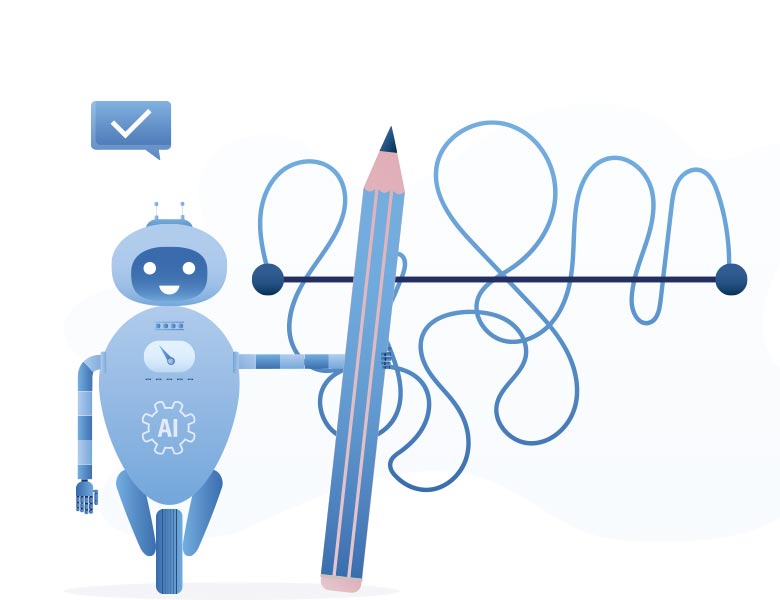
AI in PIM systems: Requirements and challenges

Stefanie Löwe
I was also one of those who were annoyed by the constant presence of reports about AI. So when my master's thesis was also to deal with the topic of "AI in PIM", I wasn't particularly pleased. Today, after almost a year of intensive engagement with the topic, I can say: AI offers an incredible number of possibilities, but you also have to develop the appropriate sensitivity for the application. Or as one of my interview partners put it: "AI is a tool, not a magic bullet for all solutions".
So I was faced with the decision: Close my eyes and go for it - or maybe find another topic after all? But something inside me said: if you have to deal with AI, then at least do it in a way that really makes sense. So I started digging through studies, items, use cases and - admittedly - a few YouTube videos. And the more I read and watched, the more I understood: the topic of AI is huge. And often quite vague.
I didn't just want to repeat the usual buzzwords. My goal was to find out what companies really need if they want to use AI in a product information management system (PIM for short). And I wanted to know which functions are actually helpful for users - not just on paper, but in everyday life.
That's why I conducted interviews. Many conversations with people who work with product data on a daily basis. I listened to them, took notes, asked questions. And sometimes I just swallowed when I realized how complex everyday life with a PIM system can really be. But that's where it got interesting.
What became clear to me pretty quickly during my research: PIM systems are something like the backbone of many companies - especially in data-intensive areas such as retail, industry or e-commerce. They ensure that all product information comes together in one central location. Whether it's technical details, marketing texts, images or sales data - the PIM system keeps everything together, structures it and prepares it appropriately for different channels.
And this is where the interaction with artificial intelligence becomes exciting. Because AI can always work particularly well when it is fed with high-quality, well-structured data. In other words: perfect conditions.
The PIM system provides the data - the AI can learn from it, analyze it and process it further. Processes can be automated, content can be adapted more quickly and the quality of product data can be increased. Sounds like a real game changer, doesn't it?
In theory, I quickly understood this. But as a project manager, I wanted to know more. I didn't just want to write down a few clever concepts, I wanted to understand what the people who work with these systems every day really need. Which AI functions really help them in their everyday lives? Where are the limits? And what do they want for the future?
Generation of text information
One of the most frequently mentioned requirements was, unsurprisingly, the generation of text information - suitable for different target groups and sales channels. A classic PIM system without AI support can only do this to a limited extent, usually using predefined rules or simple templates. And of course: a technical list text with product features can be created quickly. Even a general description text often already exists - written by someone at some point.
But vending products is not just about data - it's about people. It's about their wishes, their context, their tone of voice. And that's where AI comes in.
The use of artificial intelligence makes it possible to formulate texts in a much more personal, emotional and target group-specific way. The same product can be described very factually for the B2B catalog, while it is advertised in the online store with casual, seasonally appropriate wording - without anyone having to laboriously write all these texts.
Custom instructions are particularly helpful here. Tools such as ChatGPT make it possible to give the AI certain rules and guidelines - for example: "Please always write in the first person, casually, with a touch of humor." Or: "Use technical terms, remain factual, but clearly understandable." In this way, texts can not only be generated, but also tailored to specific channels, target groups or tonalities.
What really surprised me: Many of the interviewees already had very specific ideas about how they would use such functions - and also clear expectations. Text generation was not perceived as a gimmick, but as a real opportunity to work more efficiently and increase the quality of content at the same time.
Generation and editing of media
In my conversations, automatic image generation by AI was seen more as an exciting marketing feature - nice for illustrating creative campaigns or designing visual concepts. However, it is currently still of little relevance for day-to-day work with product data in a PIM system. The reason is obvious: although the generated images can be created with astonishing ease, they are still too unspecific, not standardized enough and in many cases cannot be used in a legally compliant manner for mass processing in a corporate context.
In addition, a closer look often reveals clear shortcomings: unnatural shadows, unrealistic material representations or anatomically incorrect details when people or hands come into play. For high-quality product communication, where accuracy and reliability are important, this is not yet sufficient. But - and this was clear to everyone involved - this is only the current state of play. The technology is developing rapidly. It is therefore quite possible that image generation will play a much greater role in a few years' time - perhaps also in the PIM environment.
What is much more practical and relevant, however, is the targeted use of AI for editing existing images. This is precisely where many companies see real added value. Automatically adjusting formats, removing backgrounds, standardizing colour schemes or cropping images for specific channels - these are tasks that often still have to be done manually today. AI can not only speed up these processes, but also ensure consistent quality, which is a real benefit, especially with large volumes of images.
Optimization of product data
One area that became increasingly important during the course of my master's thesis was the topic of "optimizing product data". It doesn't sound very spectacular at first, but in practice it is perhaps the most important lever when it comes to efficiency and quality in dealing with PIM systems. After all, even the most beautiful front end or the most sophisticated interface is useless if the underlying data is not correct.
There are usually many different users with very different backgrounds working in a PIM system - this increases the risk of incorrect entries or inconsistent data. Traditional logics quickly reach their limits here, as they can only react to predefined rules. AI, on the other hand, can recognize anomalies and outliers, e.g. values that are out of the ordinary, implausible combinations or duplicate entries. This makes it an important tool for ensuring data quality in the long term - not only retrospectively, but also preventively during ongoing operations.
Another topic that concerned many of my interview partners was automatic keywording - especially with regard to the findability of media and products. Anyone who has ever tried to search for a specific image or product in a huge database knows that good keywording is worth its weight in gold. AI can help here by suggesting suitable terms based on existing information or adding additional tags to existing content. This not only saves time, but also ensures more consistent search results - particularly important in systems that are growing daily.
The automated referencing of media and products was also frequently addressed - in other words, the question of how a specific image can be automatically assigned to the correct product or product variant, for example. The potential is great, especially for extensive catalogs or variant management. However, this function is not without its problems. In order for the AI to achieve satisfactory results, it needs clear specifications or training data. Without a defined framework, the hit rate quickly becomes unreliable - and this can lead to confusion rather than relief in everyday life. So here too, AI can provide support, but only where the necessary basis is in place.
Conclusion
Looking back on the topic today, I can say with full conviction that I am now a real fan of AI and its potential applications - especially in the context of PIM systems. What initially sounded like an annoying trend topic has turned out to be one of the most exciting tools of our time.
But - and this is perhaps the most important insight from my work - any AI is only as good as the person operating it. You need to understand what you want to achieve, how to use AI sensibly and where its limits lie. Not everything that is technically possible makes sense in everyday practice. And this is precisely where the challenge lies - especially for us as software manufacturers: recognizing and questioning customer requirements and putting them into a meaningful context.
I am convinced that AI will significantly expand the possibilities of PIM systems in the coming years - not as a replacement for existing functions, but as a supplement that makes many things easier, faster and perhaps even a little smarter. It will definitely remain exciting. And I'm looking forward to continuing along this path - with a much more open mind than a year ago.

Stefanie Löwe works in consulting and project management at crossbase. As a former graphic designer with PIM know-how, she has a special perspective on the use of a PIM system and the requirements of customers. As part of her part-time studies, she wrote her master's thesis on the topic of AI, making her an expert when it comes to the interaction between PIM and AI.
I look forward to a personal consultation with you.
Call now +49 7031 9881-770
or send me a message
Herby Tessadri
Sales Manager and Authorized Signatory

